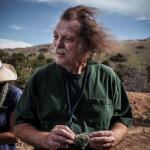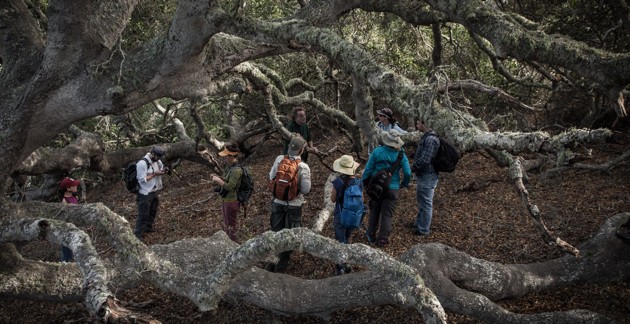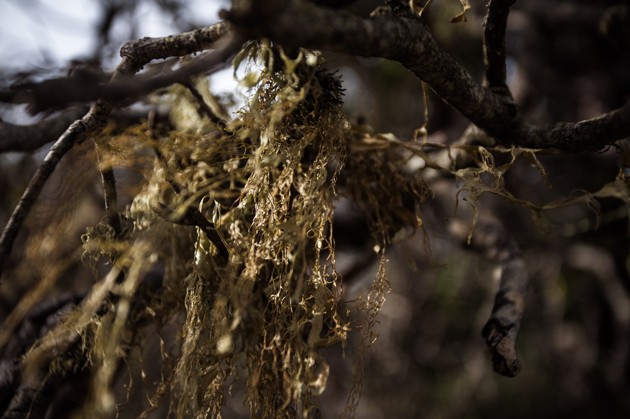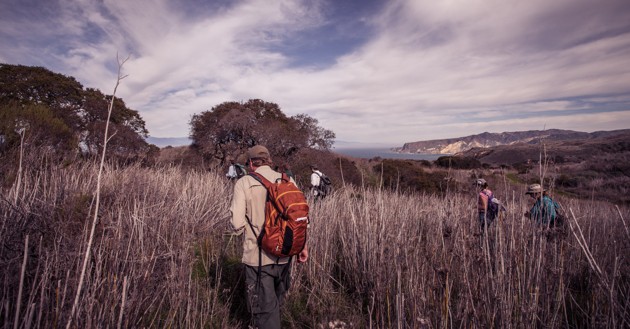The Ex-Anarchist Construction Worker Who Became a World-Renowned Scientist

“See these lichens here? I don’t know how you see them but, to me, I see them as a surrealist.”
I am sitting in the UC Riverside herbarium, speaking to Kerry Knudsen, Southern California’s only professional lichenologist. We are looking at his collection of lichens, which consists of over 16,000 individual specimens, all of them neatly organized in large green file cabinets. Knudsen has published over 200 peer-reviewed scientific papers on lichens, and discovered more than 60 species that are new to science. It is an extraordinary output, for any scientist, but Knudsen has achieved it in only fifteen years. Science is his second career. For more than two decades he worked in construction. Before that, he was a teenage runaway living in an anarchist commune in Chicago.
“He’s amazing,” said Shirley Tucker, a retired professor of botany at LSU. “He came out of nowhere and became an expert in the most difficult genera.”
A lichen is a fungus in a symbiotic relationship with an algae or a cyanobacteria. The fungus essentially farms the algae or cyanobacteria, who are able to harvest energy from the sun through photosynthesis. In return, the fungus provides the algae or cyanobacteria with protection, but the relationship is a little one-sided.
“The algae is trapped,” Knudsen explained. “It has a lot of tubes going into it. It’s controlled by chemical signals … The first time I saw it under the microscope, I wanted to join the Algae Liberation Front. I mean, it looked bad.”
Scientists believe that lichen evolved over 500 million years ago, about the same time as fish. Although lichen make up 8 percent of the world's biomass, they are rarely considered by the amateur naturalist, and therefore have very few common names. Knudsen is currently at work on several scientific papers describing the lichen on the Channel Islands, which lie off the coast of Santa Barbara. Unlike most populations of lichen in Southern California, which have suffered due to increasingly destructive wildfires, the lichen population of the Channel Islands has remained relatively protected and diverse.
“A big rock on the islands might have over twenty species on it,” Knudsen said.
People send Knudsen lichen from all over the world. In his office that day were packets of lichen from Tibet and Austria, among other places. But Knudsen's collection focuses primarily on the lichen of Southern California. While Knudsen has personally collected most of the specimens in his archive, many of them were found by his scientific predecessor, a doctor named Hermann Edward Hasse.
The son of German immigrants, Hasse served as a surgeon in the Civil War and then moved out to California and opened the first Veteran's Hospital in the United States, in Santa Monica. While in California, Hasse amassed a large collection of lichens, before passing away in 1915. Lecidea hassei, a lichen that grows inside solid rock, was named in his honor. Hasse's papers are archived at Harvard, but the majority of the lichens he discovered are kept at Knudsen's herbarium in UC Riverside. His work serves as the baseline for much of what Knudsen does.
“He’s a big inspiration for me,” Knudsen said.
* * *
Weeks before my visit to the herbarium in Riverside, I traveled with Knudsen by ferry to the Channel Islands, along with the California Lichen Society (CALS). Knudsen was giving a tour of Santa Cruz Island to CALS, which was in Santa Barbara for its annual meeting. CALS was founded in 1994 and it is dedicated to promoting the appreciation, conservation, and study of California lichens. There are approximately 200 members, although only twenty came to Santa Barbara. This past year, CALS convinced the California State Legislature to designate Lace Lichen (Ramalina menziesii) as the official State Lichen. It was approved by a 37-2 vote and its ratification made California the only state in the country with a State Lichen.
We left Oxnard Harbor at nine in the morning, along with several other tourists, and headed for Santa Cruz Island. It was a two-hour journey in rough seas and several passengers puked off the stern of the boat. Our captain, Captain Dave, informed us that today's swells were the biggest of the year. At one point, a kind crew member walked around handing out ginger candies and apologizing.
Once on the island, Knudsen ambled over to a nearby hillside, next to a stand of eucalyptus trees, and pressed his hand lens to a rock. He had found Aspicilia pacifica, a brain-white species common to Santa Cruz Island. While Knudsen observed the lichen, a park ranger welcomed the ferry passengers to the island with a few words about its history.

The California Lichen Society among the oaks on Santa Cruz Island (Whitney Freedman)
“Today we have with us world-renowned lichenologist Kerry Knudsen,” the ranger said. “I’m very happy to see him again. He’s written a lot about the lichen on Channel Islands National Park.”
Knudsen waved and then returned his attention to the rock. Normally, he carries a three-pound hammer and a two-inch wide chisel to collect lichens, but because this trip was a tour, not a collection expedition, he carried only his hand lens. He also normally carries a notebook with him and, right after the park ranger finished his speech, he told a story about one of the foxes on Santa Cruz Island running off with his notebook.
“So don’t lay your stuff down,” he warned the group. “These island foxes will steal it.”
* * *
Kerry Knudsen was born in 1950, in Whittier, California, the hometown of Richard Nixon. His father was an engineer, and his grandfather worked for Al Capone, distributing whisky. At age sixteen, Knudsen went to hear a talk by an anarchist at the local Unitarian Church.
“The guy started talking about what things would be like after capitalism …” Knudsen said. “And I liked the idea right away.”
The speaker was from Chicago and he told Knudsen that, if he wanted, he could run away from home and join their collective. Shortly thereafter Knudsen sold his record collection and bought a bus ticket to Chicago. He moved between several anarchist communes and worked at a surrealist art gallery. At first his parents tried to get him to return home but then they decided to make him an emancipated minor.
He spent three years in Chicago and then moved to New York, to the Lower East Side, with several other anarchists. For the next year he lived in New York, writing poetry and taking acid over 200 times. At a certain point he became involved in magic.
“Crowley-type things,” he explained. “You know, crazy stuff on acid.”
After New York he moved out to a commune in Placitas, New Mexico. In Placitas, Knudsen lived in a kiva, a small hole dug into the ground and covered with a wood frame. His perspective on this period of his life is surprisingly unsentimental.
“A lot of the stuff going on was just partying,” he said.
By 1970, with his hopes of full-scale political revolution dwindling, Knudsen moved back to Southern California to take a job in construction. He thought about trying to become a professor of poetry, but postmodernism was coming in and he “just didn’t like it.” Working construction seemed like a good option because he thought it would allow him to make money and keep his mind free. When he arrived for his first day on the job, the foreman asked him if he wanted to work inside for four dollars or outside for five dollars. He said he wanted to work outside.
“First thing I’m doing is digging ditches and I’m going, ‘Oh, motherfucker.’”
Knudsen spent a significant chunk of his two decades in construction working for a company that installed street lights. He estimates that he installed over 20,000 street lights across Southern California. He excelled at work, and eventually became one of the top earners in his union.
In 1979, he drove out to Ohio for a job. During the long, nonstop ride, he developed blood clots in his legs. He was taken to the hospital where a doctor told him that, sometime in the next 24 hours, he had over a 50 percent chance of dying.
“I had my girlfriend at the time bring me Lord of the Rings and I started reading it right then,” Knudsen said.
The doctors prescribed him anti-coagulates and, shortly thereafter, he returned to work. Unfortunately, in the early 90s, his legs began to deteriorate further. They became infected easily and often formed ulcers. At the urging of his doctor, he decided to walk away from construction. He was 52-years-old and he looked around for the next thing. He had always been interested in native plants and he wanted to teach himself botany. But there was a drought in Southern California at the time, and little plant life to study near his home.
“I told my daughters: ‘Whatever’s behind the house. That’s what I’m gonna study.’ And I found lichens.”
After a few years studying on his own, Kerry contributed to an Arizona State University project that sought to survey the lichen of the Sonoran Desert. Even though he had no Ph.D., his work on the Sonoran project earned him a reputation as a scrupulous and ambitious researcher. UC Riverside contacted him and requested that he open an herbarium on their campus. He concentrated the collection entirely on Southern California lichen, because he knew that no one since Hasse had comprehensively described the area.
Knudsen now lives in Prague half the year with his second wife, a Czechoslovakian lichenologist named Jana who he met online. He is employed by the University of Life Sciences in Prague to study California lichen, although he teaches no classes. The university is interested in keeping him on staff because he publishes so many papers and their funding is, in part, determined by the number of papers their faculty produce.
“I get paid to write their university’s name on the papers,” Knudsen explained.

Lace Lichen, the official California State Lichen as of January 2016 (Whitney Freedman)
In 2009 he experienced a moment of fleeting Internet fame after he named a species he had discovered on Santa Rosa Island after the newly-elected President Obama. The species was named Caliplaca obamae. It had barely survived on Santa Rosa Island, after years of over-grazing by non-native cattle, deer, and elk. Knudsen completed the final draft of the paper that described the new species on the day of President Obama's inauguration. I asked Knudsen what Caliplaca obamae looked like:
“Oh it’s just a little orange, sterile thing that grows on the dirt,” he said.
* * *
After a brief lunch, Knudsen and CALS began their tour of the island. Their movement down the trail was halting. The expedition would not get far before one of its members would pause and kneel to inspect a lichen with their hand lens. This, I was told, is a common feature of lichen hunting expeditions.
“You get to know everyone by the way their butt looks,” one CALS member told me.
Knudsen hobbles when he walks, due to the damage done to his legs by the blood clots. But he still finds a way to pursue lichens in hard-to-reach locations. As we made our way across the island, he would periodically scramble up a hillside and press his hand lens to the base of a tree or a fence post. He would lay on his stomach, or roll over on his back. By the end of the day there were bits of twig and lichen in his hair. He seemed pleased with the day's findings.
Lichens grow very slowly and certain species have extraordinarily long lifespans. Samples of Rhizocarpus geographicum, for example, a lichen that grows in the arctic, were determined to be over 8,000 years old. Knudsen’s research focuses on Acarosporaceae, a genera of lichen that is notoriously difficult to identify. Like many lichen, Acarosporaceae produces its spores inside of a cylindrical structure known as an ascus. Unlike most lichen, which produce about 8 spores per ascus, Acarosporaceae has over 100 spores per ascus. When it rains, hydraulic pressure is applied to the ascus, and its spores are launched into the world like cannonballs, at a speed of 250 miles per hour. Many of them land nearby, but others drift into the stratosphere and may end up floating for hundreds of miles.
“They can travel,” Knudsen said. “And over millions of years they have really wide distributions in some cases.”

The California Lichen Society trudges through a stand of dry fennel on Santa Cruz Island (Whitney Freedman)
As we walked back to the docks to catch the ferry, I asked Sarah Minnick, the Secretary of CALS, what drew her to lichen. She told me that she was interested in wildlife and larger plants as well, but that she enjoyed learning about lichen because they were everywhere. Lichen are right there and no one ever notices them, she explained. But once you start noticing them, it’s like a whole universe opens up to you.
On the ferry ride home Knudsen drank a beer and explained the biology of lichen to several rapt tourists. Thanks to the introduction by the park ranger, he was now something of a celebrity on the ride back to Santa Barbara. At a certain point during the trip, Captain Dave paused momentarily and attempted to locate a pod of gray whales. We’d seen a couple whales on the way out and he wanted to see if we could find them again. Tourists gripped the railings and scanned the horizon, hoping to get one last glimpse of the massive mammals. But they had disappeared.
* * *
The day after our trip to Santa Cruz Island, Knudsen gave a talk to all the CALS members about his work in the San Bernadino and San Jacinto mountains. Before searching the Channel Islands for lichen, Knudsen had been surveying the two mountain ranges with James Lendemer, the Lichen Curator for the New York Botanical Garden. He spent most of the talk joyously describing the many lichen he and Lendemer found, including a couple rare species that Hasse had discovered many years ago. But toward the end of the speech, as he addressed the effects of wildfire in the region, he grew visibly irritated. 100 years from now, he explained, many of the rare species that he and Lendemer found will be extinct.
“A lot of the records in this study are going to be things that people look for and say, ‘It used to be here.’”
It takes a lichen population over fifty years to recover after a substantial fire. Most rare lichens will be completed wiped out if the region where they grow experiences a fire. As a result of climate change, fires throughout Southern California are expected to increase in both magnitude and frequency. In 2015 alone there were over 6,000 fires in California, including the Butte Fire, in Amador County, which forced Governor Jerry Brown to declare a state of emergency.
“There’s nothing we can do to protect these species except stop climate change,” Knudsen said.
Knudsen wants to do the best he can to document the diversity and beauty of Southern California lichens while he has the chance. Because lichen are such sensitive organisms, they are often used as indicators of air quality, but otherwise they have little economic value.
“Some people ask me: What good are lichens?” he said. “Just like every human being, lichens basically are valueless. Their value is that they are alive. That they are in themselves. They have no use except their own beauty and life.”
With the world on the brink of climate change, Knudsen is interested in leaving as detailed a record of the way things are in California before its landscape begins to transform. Though he is the region’s only lichenologist, he imagines that some time in the future someone will uncover his work, the way he has uncovered Hasse’s.
“Right now I don’t have anyone to replace me,” he said.
